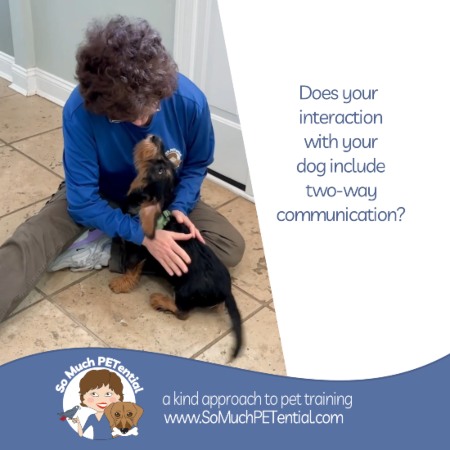I’m working with several families now who have called because of differing reactive behavior in their dog, barking and lunging on leash or barking at guests in their home. Anytime I am helping families with a behavior issue in their dog, one of the early steps is coming up with a management plan to prevent their dog from practicing his/her undesirable and underlying emotions. The scientific term for that plan is called antecedent arrangement. It has an important role in teaching and changing behaviors. This mailbox on the outside of my client’s door, is a great example.
 What is antecedent arrangement?
What is antecedent arrangement?
The first thing to understand is that NO behavior happens out of the blue. Sometimes it may seem like that, but if you do enough detective work, you can find a cause.
Consequences of behavior are what has the power to strengthen or weaken behavior. When a behavior gets the animal a consequence it values (and only that specific animal can determine that), then the animal will more than likely keep doing the behavior – even strengthen the behavior.
However, when does an animal know to do a particular behavior? That is where the antecedent comes into the picture. Antecedents are the setting events for the behavior, they are what happens BEFORE the behavior that sets the stage for that behavior to occur. Distant antecedents are nutritional, medical and variables that can impact behavior such as pain, lack of sleep or exercise, noise, trigger stacking, or anxiety. Immediate antecedents are what occurs IMMEDIATELY before the behavior such as proximity to something (like a face that is too close, just before a bite), the sight of something, or a verbal cue (such as telling your dog to sit).
When you analyze the environment to see what is occurring to set the stage for any particular behavior, you can pro-actively make some changes to make that undesirable less likely or the desirable behavior more likely. This is antecedent arrangement.
Why is antecedent arrangement important in animal training?
Whether you are trying to come up with a solution for a problem behavior such as resource guarding, barking/lunging at passers by or jumping on visitors; or trying to teach your pet a new trick, antecedent arrangement can play a huge role.
Remember, behaviors that are practiced (and reinforced by consequences) are going to strengthen. Therefore, you’ve got to find a way to prevent your pet from practicing those undesirable emotions and behaviors in order to teach different responses.
For my clients who want to change their dog’s response from barking at people and dogs, to turning back to the handler instead, that mailbox outside the house can be important. Otherwise, every day that their dog practices having an increased heart rate when he/she hears a person (who could be the mail carrier) walking to the door followed by thrashing back and forth, destroying the mail that comes through the slot, is practice of barking/lunging/increased heart rate at the approach of a person.
Sometimes antecedent arrangement is all that is needed to modify a behavior (a least invasive strategy).
For a dog that is reactive because of pain or underlying anxiety, addresses the physical issue can make a huge difference in that dog’s response to his/her environment.
If your dog is on high alert for squirrels and lizards all day, that is creating chronic stress which has all kinds of side effects. A window cling or other method of blocking access to that window can have a big impact on behavior.
When I had Chester, my Alexandrine Ringneck Parakeet (he died many years ago), if out, he was prone to seek out draperies or furniture to get his chewing needs met. So, I created Chester enrichment stations in several rooms that included activities I knew he loved to do. By doing that, Chester no longer had a need to get off his cage in search of table legs. His needs were being met in another way. (I also made sure that his cage area had more enrichment to raise the value of his wanting to stay on his cage)
Antecedent arrangement in training
Ask yourself, how can you arrange things to make the right choice the easiest? Below are just a few strategies I have used:
I brought my then young puppy into my enclosed kitchen with nothing else on the floor to begin teaching him value in going to his bed. There were no distractions present so he could better focus.
I’ve used targets on the ground to direct an animal to move in a certain way.
I’ve increased distance from a distraction if that distraction is making it too difficult for my learner to pay attention.
I’ve delivered treats in certain directions in order to make it easier for the animal to do another repetition of the behavior.
The uses for antecedent arrangement are vast. You more than likely do it without even realizing you are doing it. That relationship between the setting event and the behavior should always be carefully thought out because it can have such a powerful effect on a modification plan…and it is the least intrusive solution.







